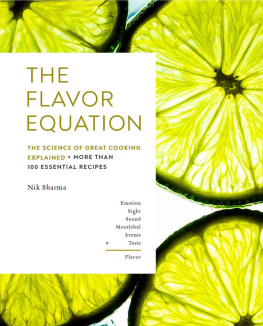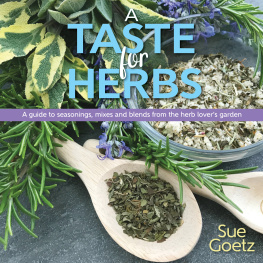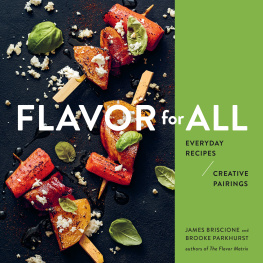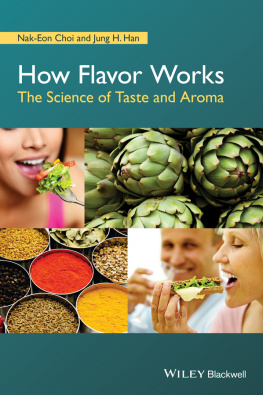

Emotion |
Sight |
Sound |
Mouthfeel |
Aroma |
+ | Taste |
Flavor |

For Floyd Cardoz, who made Goan cuisine shine bright.
For Michael, who makes me laugh.
Text and photographs copyright 2020 by Nik Sharma.
Illustrations copyright 2020 by Matteo Riva.
All rights reserved. No part of this book may be reproduced in any form without written permission from the publisher.
Library of Congress Cataloging-in-Publication
Data available.
ISBN 978-1-4521-8285-8 (epub, mobi)
ISBN 978-1-4521-8269-8 (hardcover)
Prop styling by Nik Sharma.
Food styling by Nik Sharma.
Design by Lizzie Vaughan.
Typesetting by Howie Serverson.
The photographer wishes to thank the Biological Imaging Facility, University of California, Berkeley.
Ajinomoto is a registered trademark of Ajinomoto Co., Inc.; Alinea is a registered trademark of The Alinea Group LLC; Cadbury is a registered trademark of Cadbury UK Limited Corporation; Gjelina is a registered trademark of Frescos Gym LLC; King Arthur Flour is a registered trademark of The King Arthur Flour Company, Inc.; Lao Gan Ma is a registered trademark of Guiyang Nanming Laoganma Special Flavour Foodstuffs Co., Ltd.; Lee Kum Kee is a registered trademark of Lee Kum Kee Company; Lyles Golden Syrup is a registered trademark of T&L Sugars Limited Company; Maggi is a registered trademark of Societe des Produits Nestle; Maldon is a registered trademark of Maldon Crystal Salt Company; Marmite is a registered trademark of Conopco, Inc.; Namu Gaji is a registered trademark of David Lee; Nestl is a registered trademark of Societe des Produits Nestle; PBS is a registered trademark of Public Broadcasting Service Corporation; San Francisco Chronicle is a registered trademark of Hearst Communications, Inc.; Serious Eats is a registered trademark of Serious Eats LLC; Vegemite is a registered trademark of Bega Cheese Limited.
Chronicle books and gifts are available at special quantity discounts to corporations, professional associations, literacy programs, and other organizations. For details and discount information, please contact our premiums department at or at 1-800-759-0190.
Chronicle Books LLC
680 Second Street
San Francisco, California 94107
www.chroniclebooks.com



Foreword
I have spent more than 40 years trying to understand food science. I started with Harold McGees classic On Food and Cooking, which, to this day, I find both brilliant and impenetrable. Next, I used Shirley Corrihers CookWise and BakeWise, both of which bridged the gap nicely between science and cooking. I worked with Bob Wolke (What Einstein Told His Cook), a man with a sense of humor and good storytelling skills. Finally, I have worked for many years with Guy Crosby, Milk Streets in-house food scientist, who answers our day-to-day questions, such as Why cant you make mayonnaise during a thunderstorm (or can you)? and Why did a duck braised in red wine explode in the oven?
Crosby admitted that he restricted his answers to my questions based on his perception of my ability to understand. Over the years his description of gluten became more and more complex, starting with gluten content, moving on to glutenin and gliadin, then discussing prolamins. This reminds me of my sixth-grade science teacher who, when I asked if molecules actually looked like his colorful wooden balls and dowels, told me they did not. Why? I asked. He replied, Because thats all you can handle. The message was clear: There is something deeply unfamiliar behind the curtain, something way beyond the ken of the average home cook.
Enter Nik Sharma. I first interviewed Nik years ago on Milk Street Radio and was won over by his combination of authenticity and enthusiasm for his adopted homehe grew up in Bombay and moved to Americastirred by his love of marrying Indian and American culinary traditions. His father hailed from northern India and his mother from Goa, places with cuisines that are about as similar as Lowcountry seafood is to Vermont pot roast, so he was well prepared for the future. His food has always reflected the underpinning of flavor from his childhood, a lesson that he puts to good use no matter what and where he is cooking.
The Flavor Equation is written by someone who understands flavor first. This is not a book for geeks who want to dive deep into amino acids, gels, and osmosis. This is a book about how to turn out food that optimizes flavor. For Sharma, flavor is visceral and complex. It is emotion, sight, sound, mouthfeel, aroma, and taste. Flavor is also brightness, bitterness, saltiness, sweetness, and savoriness. The cooking of India, which incorporates dozens of regional and local cuisines, perfectly represents this complexity.
In northern European cuisines, dishes tend to be played in a major key. In plenty of other spots around the globe, home cooks are playing music that is chromatic and even atonal at times, finding the notes between the notes to make you sit up and ask, What did I just taste? It is subtlety and daring all in one forkful.
Nik Sharma and others are teaching us that good food is not about technique per se: years standing in front of the stove, advanced knife skills, and mastering pastry technique. Its about crafting flavor through an understanding of what flavor actually is. This style of cooking doesnt have to be precarious or even highly skilled, but it does have to thoughtful. Sharma shows us how to make tomato soup, lamb chops, chicken salad, fruit crisps, and spareribs in new ways by thinking about the push and pull of texture and flavor. This offers a transformational way forward for anyone who wants to grow from good cook to great cook, all without classic French training.
Christopher Kimball
founder, Milk Street
Introduction
What makes a recipe cooked in a home kitchen or the meal served at a restaurant taste spectacular and delicious? What makes it inviting and special? Why do we like some foods more than others? The answers to these questions lie in our perceptions of flavor.
Flavor symbolizes different things to different people. It might represent the aroma and taste of a dish prepared with love by a parent or grandparent, or an opportunity for food culture to be passed on to a younger generation. For some, it might jog the memory of a meal that provided comfort when the world was harsh or represent a path to an immigrant who longs to connect with the country of their birth as well as their adopted home.
Flavor is much more than a distinctive smell or taste; it involves our emotions, and sometimes memories, intertwined with our sense of the sounds, colors, shapes, and textures of our food. These components together make what I refer to as the Flavor Equation:
Next page











